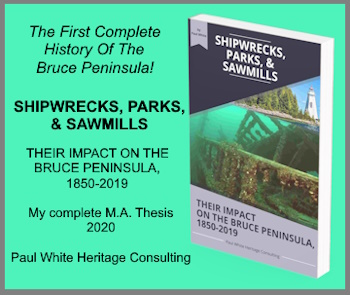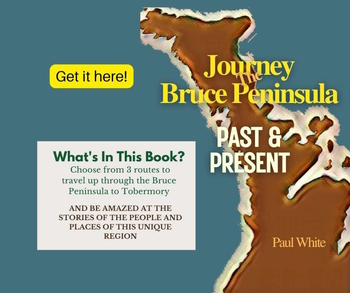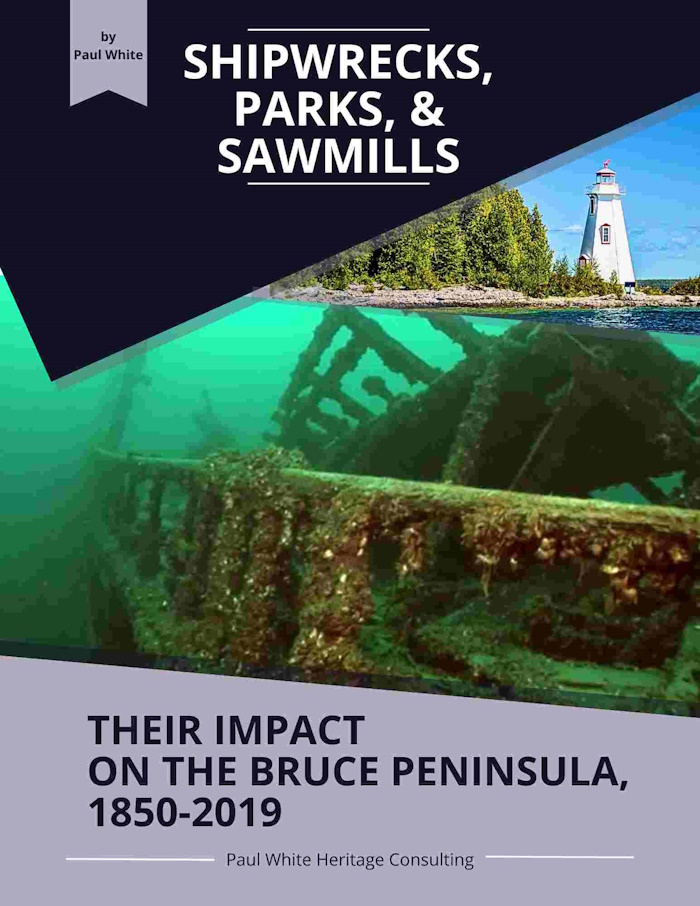12th of July and Dominion Day Celebrations on the Bruce Peninsula
The 12th of July and Dominion Day celebrations on the Bruce Peninsula were an outlet from the everyday drudgery of life for pioneers on the Bruce Peninsula.
The 12th of July and July 1st have always been occasions to celebrate in Owen Sound and Grey-Bruce region.
Of course, July 1 has been the cause for celebration in this area since 1867 and the strong influence of the Orange Lodge here has led to much merry making in the celebration of the Battle of the Boyne on the 12th of July.
As a child, I remember many July 1st weekends spent with friends and family at Sauble Beach, Southampton, and other sandy and sunny spots on the Bruce Peninsula. It was time to wave small Union Jacks (in the years before Prime Minister Pearson promoted our current flag), let off fireworks and, in general, and have a good time.
The 12th of July has Special Family Significance
The 12th of July has a special meaning in our family. It was my grandmother's birthday. As well, my mother’s family were, staunch members of the Orange Lodge. My earliest recollection of 12th of July celebrations was to travel to Parkhead to watch with pride as my Grandfather Rowe marched in what was probably the last Orange Parade in which he was able to take an active part.
Dominion Day a Special Day on the Setters' Calendar
Dominion Day was a time when the world of commerce and everyday life came to a halt in the early years on the Bruce Peninsula. Chores were completed early, while the women of the family put together picnic baskets with all the treats they had baked the previous days. When all was ready, the entire family walked, or took the horse and wagon, off to the church or school yard for a community celebration. In some of the port towns and villages, special holiday excursions were planned aboard a local steamer to another community where competitions, dances, and picnics were held.
Participation in these events was so widespread that the July 4, 1879 Wiarton Echo reported that "Dominion Day passed off very quietly in this village, the inhabitants mostly taking advantage of the boat excursion to Big Bay and around the islands on the Prince Alfred."
The Echo went on to describe in great detail the events of the excursion to Big Bay. The story stated that Dominion Day was celebrated with more "than the usual éclat." People arrived early by horse and wagon to prepare for the day’s sporting events. However, "the crowd was considerably augmented when the Prince Alfred arrived from Wiarton, Colpoy's and Oxendon.”
The boat races began at 10:30 a.m. with the double scull race which had two entrants. The single scull event followed with three participants. Finally, in the final water event, five boats were entered the yacht race.
Other sporting events followed, including baseball games, organized and otherwise. For those not interested in athletic endeavours, there were other amusements. The Echo reported that by the day's end, "all were quite satisfied" and that no mishaps had occurred and that the “people of Big Bay deserve great credit for the manner in which the affair was conducted.”
Although this column has featured only the July 1 events in Big Bay in 1879, all of the area newspapers detail similar celebrations being carried out each year on Dominion Day.
The Wiarton Echo also detailed similar events for the celebrations of 12th of July. In 1879, it was reported that the Meaford branch of the Orange Lodge would be coming to Wiarton on an excursion that day and that Wiarton area hotels, inns and private citizens were preparing to give their fellow Orangemen, and their families, every possible accommodation.
For those citizens of Wiarton who wished to travel, the Prince Alfred was offering a “July 12 Grand Excursion to Owen Sound.” Return fare between Wiarton and Owen Sound was 75 cents, return from Big Bay was 30 cents and a round trip from Presqu'ile was 25 cents.
It is obvious that both the 12th of July and Dominion Day provided the early citizens of this region with an outlet from the day-to-day drudgery and hard work necessary for survival in pioneering conditions. For many families, these holidays continue to be a time for recreation and enjoyment and therefore a break from the regular workday routine.
The notes and other information concerning the Dominion Day and the 12th of July festivities on the Bruce Peninsula were made available due to the research efforts of Judith Coates.
A version of this article first appeared in my Local History column in the Owen Sound Sun Times.
Bruce Peninsula Towns & Villages
Towns & Villages: The first Bruce Peninsula towns and villages had a source of water power to run sawmills and a good harbour to ship forestry products to market.
The 12th of July and Dominion Day Celebrations on the Bruce Peninsula were an outlet from the everyday drudgery of life for pioneers on the Bruce Peninsula.
Allenford United Church history details some important information about that community's church but also about one of the founders of this Ontario community.
A Pioneer Community: Driftwood Crossing (now Allenford): at the southern-most part of the Saugeen/Bruce Peninsula was at the midpoint between the Georgian Bay and Lake Huron coasts.
Land Auction in Amabel Township provided the opportunity for settlers to purchase land and begin a new life in Bruce County. On July 18, 1856, a notice signed by R.T. Pennefather, superintendent general the Indian Department, announced the public auction sale of 144,000 acres of land in the new townships of Amabel and Keppel.
Barrow Bay Ontario: a Picturesque Georgian Bay Community owes its origin to the once-thriving Bruce Peninsula lumbering industry. Today it is a quiet summer get-away!
Bruce Peninsula Municipal Politics: No matter what the venue, or the issue, seldom is a decision made that suits everyone.
Bruce Peninsula Newspapers Rivalry between the Wiarton Echo and Owen Sound newspapers promoting their communities was often vitriolic and led to acrimony between the two communities.
Dyer's Bay Ontario: Began as a lumbering settlement but may also have been one of the earliest points on the Bruce Peninsula to be visited by French explorers.
Elsinore Ontario: In the mid-1850s the first settlers arrived in the area just west of Allenford. However, it was not until 1865 when the North Gravel Road, or Highway 21 as it known today, was built that the village of Elsinore was established.
Hepworth Ontario: The early history of Hepworth is tied to two essential commodities, sawmilling and transportation. How Hepworth got its name is also an interesting story.
Lion's Head remained an important lumbering centre into the twentieth century. Today it is a centre of tourism, and the lion's head still guards the southern entrance to the bay. However, the same elements that created the image have continued to erode the rocky outcropping.
Park Head was an important Grand Trunk Railway depot on the Bruce Peninsula.
Sauble Beach: This popular beach in the 1950s was called Canada's Daytona Beach.
Sauble Beach Ontario is one of the most popular summer resorts in the province of Ontario. It welcomed its first summer visitors in the late 1800s and as continued to grow in popularity since that time.
Stokes Bay welcomed fishermen as their first non-native visitors. Today, if you are a fisherman, you will also probably want to try your luck landing a walleye, lake trout or any of the other game fish that live in the coastal waters of Lake Huron.
Tobermory Ontario has a rich history and, is the northern- most destination point for travellers visiting the world famous Bruce Peninsula.
Tobermory Ontario Tourism is focused on Fathom Five National Marine Park, Bruce Peninsula National Park, and, shipwreck diving which has become so popular that tourism has become an important part of that community's economy.
Tobermory Pioneers were first the fishermen who came to reap the rewards of the fishing-rich waters at the top of the peninsula.
Tupper Murray was one of the first names given to the community at the top of the Bruce Peninsula
Wiarton Ontario was known for its excellent natural harbour. It seemed to be a natural choice for the location of a port community. Colpoys Bay offered a natural harbour refuge for sailing vessels from storms on the often-tumultuous waters of Georgian Bay. As well, the harbour was located at the portage route across the base of the Bruce ...
Wiarton had Ambitions to Succeed but while success brought them a railroad and other ventures, one attempt did not have a sweet ending for many in the town.
Wiarton News: 1897 Town Council Report. By 1897 Wiarton was an established community and was experiencing some of the growing pains consistent with a community which was constantly expanding its physical borders. A November 1897 Wiarton council meeting reveals some the problems which that community was facing.
Wiarton Beet Industry: Wiarton's Sweet Enterprise Turns Sour! In their attempts to diversify Wiarton's economic base, a dramatic new industry was incorporated in 1896. Originally called the Owen Sound Sugar Manufacturing Company, the Wiarton Beet Sugar Manufacturing Company looked like it would have a large impact on the economy of the Wiarton area.
Wiarton Ontario's First Newspaper: The Echo viewed itself not only as a messenger of the news of the day, but also as a medium to promote the development of the interests of the Bruce Peninsula, and more particularly those of Wiarton.





